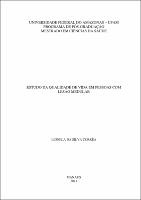| ???jsp.display-item.social.title??? |


|
Please use this identifier to cite or link to this item:
https://tede.ufam.edu.br/handle/tede/3663Full metadata record
| DC Field | Value | Language |
|---|---|---|
| dc.creator | Corrêa, Lionela da Silva | - |
| dc.creator.Lattes | http://lattes.cnpq.br/0276334550669174 | por |
| dc.contributor.advisor1 | Lopes Neto, David | - |
| dc.contributor.advisor1Lattes | http://lattes.cnpq.br/2310111492854434 | por |
| dc.date.available | 2015-04-09 | - |
| dc.date.issued | 2011-10-31 | - |
| dc.identifier.citation | CORRÊA, Lionela da Silva. Estudo da qualidade de vida em pessoas com lesão medular. 2011. 78 f. Dissertação (Mestrado em Ciências da Saúde) - Universidade Federal do Amazonas, Manaus, 2011. | por |
| dc.identifier.uri | http://tede.ufam.edu.br/handle/tede/3663 | - |
| dc.description.resumo | O tema qualidade de vida vem ganhando interesse na área da saúde nas últimas décadas. Por se mostrar um ótimo indicador de satisfação em vários aspectos da vida para investigar e avaliar pacientes, intervenções terapêuticas, e serviços na área da saúde. Esse estudo teve por objetivo avaliar a qualidade de vida de pessoas com lesão medular traumática com base na percepção do lesado medular. Os sujeitos da pesquisa foram indivíduos com lesão medular traumática, residentes na cidade de Manaus, que foram acometidos pela lesão no período de 2000 a 2010 e que deram entrada no Hospital Universitário Getúlio Vargas - HUGV. O instrumento utilizado para mensurar a qualidade de vida dos sujeitos foi a versão em português do World Health Organization Quality of Life Bref. Também foi aplicado um questionário sócio demográfico para caracterizar os sujeitos bem como conhecer as causas do trauma e tempo de lesão. E foi averiguado o nível de independência funcional dos sujeitos através do questionário de medida de independência funcional MIF. A análise dos dados foi realizada por meio da estatística descritiva e para correlacionar as variáveis, idade, gênero, independência funcional, condição socioeconômica, tempo de lesão, sequela com a qualidade de vida dos sujeitos foi utilizado o coeficiente de correlação de Spearman. Os resultados apontaram para um nível de qualidade de vida médio, e entre os domínios de qualidade de vida os que apresentaram menor satisfação entre suas facetas foram os domínios: social e ambiental. De um modo geral o domínio que apresentou menor escore foi o domínio ambiental. Ao verificarmos se existia correlação entre as variáveis a única que apresentou correlação foi a idade, quanto menor a idade melhor a avaliação de qualidade de vida talvez por uma melhor inserção social por parte dos mais novos. Concluímos que os fatores que levam a uma avaliação de qualidade de vida para um nível negativo são fatores externos, ou seja, algo que não é inerente a deficiência ou déficit, mas inerente às condições ambientais | por |
| dc.description.abstract | Quality of life theme is gaining interest in health in last decades. Because has proved a powerful tool for investigating and assessing patients, therapeutic interventions, and services in health. This study aimed to evaluate the quality of life of people with traumatic spinal cord injury based on the perception of the injured spinal cord. The subjects were individuals with SCI living in the Manaus city, which were affected by the injury in the period 2000 to 2010 and received at the Getulio Vargas University Hospital - HUGV. The instrument used to measure quality of life was the subject of the Portuguese version of the World Health Organization Quality of Life - Bref. A questionnaire was also applied to characterize socio-demographic subjects as well as knowing the causes of trauma and time of injury. It was examined the level of functional independence of the subjects through the Functional Independence Measure - FIM. Data analysis was performed using descriptive statistics and correlate the variables, age, gender, functional independence, socioeconomic status, time of injury, the sequel to the quality of life of individuals we used the Spearman correlation coefficient. The results showed a level of quality of life mean, and between the domains of quality of life those who had lower satisfaction among its facets were areas: social and environmental. In general the domain with the lowest score was the environmental field. When I checked whether there was correlation between the presenters that the only correlation was the age, the younger the better the assessment of quality of life perhaps better social integration on the part of the newest. We conclude that the factors that lead to an assessment of quality of life to a negative level are external factors, in other words, something that is not inherent in disability or deficit but inherent to environmental conditions. Keywords: quality of life, spinal cord injury, personal satisfaction. | eng |
| dc.description.sponsorship | Fundação de Amparo à Pesquisa do Estado do Amazonas | - |
| dc.format | application/pdf | por |
| dc.thumbnail.url | http://200.129.163.131:8080//retrieve/9323/Lionela%20Correa.pdf.jpg | * |
| dc.language | por | por |
| dc.publisher | Universidade Federal do Amazonas | por |
| dc.publisher.department | Faculdade de Medicina | por |
| dc.publisher.country | BR | por |
| dc.publisher.initials | UFAM | por |
| dc.publisher.program | Programa de Pós-graduação em Ciências da Saúde | por |
| dc.rights | Acesso Aberto | por |
| dc.subject | Qualidade de vida | por |
| dc.subject | Traumatismo da medula espinal | por |
| dc.subject | Satisfação pessoal | por |
| dc.subject | Quality of life | eng |
| dc.subject | Spinal cord injury | eng |
| dc.subject | Personal satisfaction | eng |
| dc.subject.cnpq | CIÊNCIAS DA SAÚDE | por |
| dc.title | Estudo da qualidade de vida em pessoas com lesão medular | por |
| dc.type | Dissertação | por |
| Appears in Collections: | Mestrado em Ciências da Saúde | |
Files in This Item:
| File | Description | Size | Format | |
|---|---|---|---|---|
| Lionela Correa.pdf | 1.69 MB | Adobe PDF |  Download/Open Preview |
Items in DSpace are protected by copyright, with all rights reserved, unless otherwise indicated.




